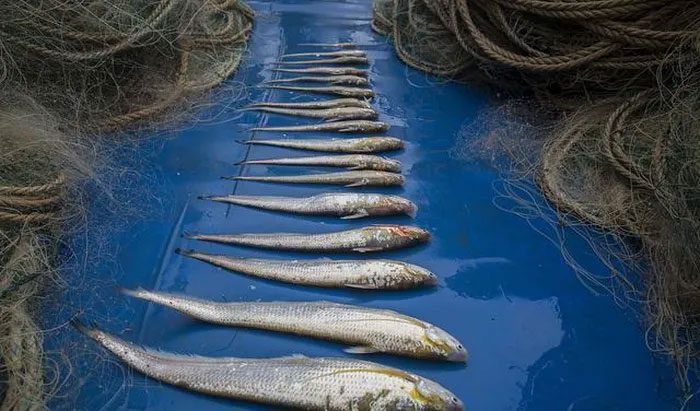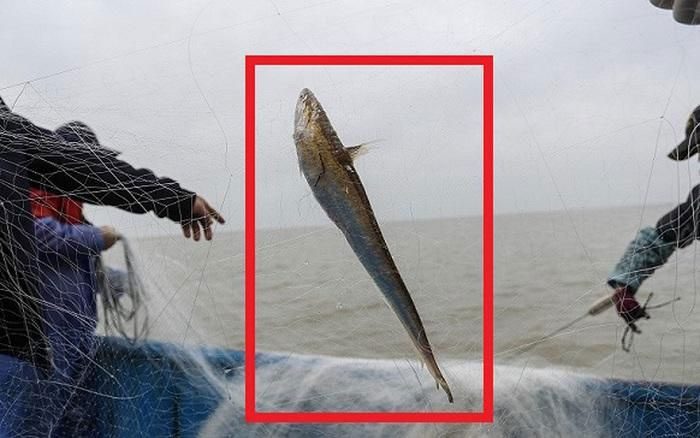According to The Paper, this may be one of the most expensive freshwater fish species.
In 2012, at an auction in Zhangjiagang (Jiangsu, China), a Yangtze River sturgeon measuring 45.3 cm and weighing 325 grams was sold for 59,000 RMB (approximately 190 million VND), equivalent to about 4 taels of gold at that time.
Before the fishing ban, the price of Yangtze River sturgeon was determined based on size; generally, fish weighing over 100 grams could sell for 6,000 RMB/kg, and fish weighing over 150 grams would cost double. Therefore, even if not auctioned, the price of the fish over 300 grams would exceed 20,000 RMB/kg.
Types of Sturgeon
Initially, sturgeon was a common food on dining tables, but due to overfishing, they gradually disappeared, driving prices up.
The Yangtze River sturgeon is a migratory fish that usually lives in the sea and does not school; however, during the breeding season from February to March each year, they gather at Haikou and swim upstream to spawn.
Although sturgeon are small in size, during the breeding season, they grow in large numbers, making them the most economically significant fish species in the Yangtze River, and even along the entire coastal area.

Yangtze River sturgeon. (Photo: Sina).
As an economically significant fish, sturgeon is divided into several types depending on their habitat, including river sturgeon, lake sturgeon, and sea sturgeon.
Besides the Yangtze River sturgeon, China also has Xinhui River sturgeon, Yellow River sturgeon, and Qiantang River sturgeon…
All migratory sturgeon species share similar “experiences,” but due to overfishing, they have become endangered. Currently, fishing for Yangtze River sturgeon is banned, but sea sturgeon is still being caught, leading to its circulation in the market.
However, sea sturgeon does not undergo the migratory breeding process and lives in seawater, with its taste considered much inferior compared to that of river sturgeon.
Why is Yangtze River Sturgeon the Most Expensive?
Among the sturgeon species in China, the Yangtze River sturgeon is the most famous and commands the highest prices.
Previously, the Yangtze River sturgeon was less at risk of extinction, mainly due to low demand and limited fishing techniques.
With advancements in fishing technology, products began circulating throughout China, leading to a surge in demand for sturgeon, peaking in the 1970s.
According to Chinanews, in 1973, the yield of Yangtze River sturgeon reached 3,750 tons, so at that time, they only cost a few RMB per kg.
By 1983, in just ten years, the annual yield of Yangtze River sturgeon had plummeted to just 370 tons; since the 20th century, it has never exceeded 100 tons.
Due to the sharp decline in catch yields, the price of sturgeon began to rise significantly. In 2014, during peak season (March), the entire Yangtze River could not yield 50 kg/day, leading to a dramatic increase in sturgeon prices.

The rarer the species, the more expensive the sturgeon becomes. (Photo: The Paper).
The Yangtze River sturgeon has unique cultural value. It has a profound influence on the cuisine of the Yangtze River region and has even been featured in poetry.
As its fame grew, it became more sought after, leading to a continuous depletion of Yangtze River sturgeon populations. The increasing rarity has made it a luxury item, with consumers enjoying sturgeon using it as a status symbol.
Not Everyone Enjoys It
In reality, many people believe that sturgeon does not necessarily have a “divine flavor.” On the contrary, they are small with little meat, making them less appealing to younger consumers.
However, as long as it is expensive and sufficiently rare, its value increases.
Due to their aggressive nature, when caught in nets, they thrash desperately, often dying within minutes of being out of water, complicating artificial breeding efforts.

Due to their aggressive nature, when caught in nets, they thrash desperately until death.
In recent years, the sturgeon farming industry in China has made significant strides. Although farmed sturgeon is relatively inexpensive, very few people consume it, and it often goes unnoticed, indicating a limited market for consumption.
In this context, young consumers who already dislike eating fish and those who wish to use sturgeon as a status symbol are even less likely to be satisfied with farmed varieties.
Starting in 2021, China has implemented a ten-year ban on sturgeon fishing to restore the ecosystem of this species.




















































